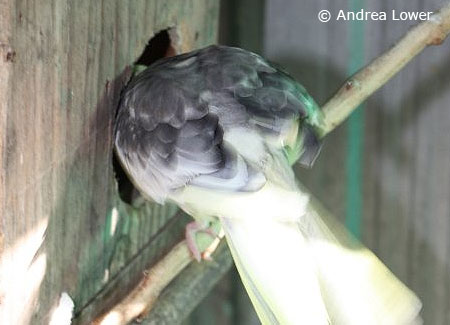|
Breeding
Cockatiels (Part 1)
Cockatiels are not difficult to breed and many will breed
throughout the year if the conditions are right. They often rival
the budgie for their willingness to breed. They come in many
different color mutations. Because of these traits, many breeders
find breeding cockatiels enjoyable as a hobby. Breeding healthy
cockatiels takes work by their keepers and the breeding pair.
These birds need to be kept clean, have a variety of foods, and
need to be continually monitored. Many things can go wrong and it
is important that the breeder be one step ahead of the parents.
Producing healthy chicks is an art.
Selecting a Pair of cockatiels

When selecting a pair of cockatiels for breeding, it is important
to find healthy birds. Finding healthy birds can easily be done
through a reliable breeder or from local pet shops. When
selecting your birds, make sure their eyes are clear and there are
no nasal discharges. A healthy cockatiel will be alert and
active. Though they may sit on their perch ruffled up, your
presence should cause them to tighten their feathers. The bird
should not be underweight and its feathering should be sharp and
smooth. Healthy cockatiels make every effort to stay pristine.
cockatiel Breeding Methods
When breeding, decide if you are going to colony breed cockatiels
or if you are going to breed pairs in individual cages. Whatever
method you choose, make sure it fits your budget, time, and
birds. If you decide to breed cockatiels in an aviary setting,
keeping accurate records is not possible. Though cockatiels can
form monogamous bonds, they still tend to stray. As a result,
producing mutations can be difficult.
Breeding in individual cages has many benefits. Firstly, birds
do not have to compete for nesting sites and secondly accurate
records can be kept. This keeps aggression down and the pairs can
concentrate on producing healthy chicks. If the parents are
allowed to focus on the social dynamics of a flock many problems
can arise. Another advantage of isolating your breeding pairs is
monitoring the chick’s growth. It is much easier to remove babies
from nesting boxes mounted outside compartment cages. Aviaries
make checking the babies difficult. The babies need to be weighed
and banded; having easy access to them is less stressful on the
parents and will less likely cause them to abandon their babies.
Breeding Setup
It
is important to keep the cage as clean as possible. Chicks can
easily develop bacterial infections inside their crops if rancid
food or dirty water is left for their parents to eat or drink.
Special care must be used when placing perches into the cage.
Perches that are placed above food and water bowls will become
contaminated with poop. Food dishes and perches must be cleaned
regularly to keep harmful bacteria to a minimal.

When breeding cockatiels in individual compartments, it is
important to keep the nesting box mounted outside the cage. The
entrance hole should be the only part exposed to the birds. A
nesting box placed inside a cage will end up as a courting
platform and will be filled with poop. This harbors bacteria and
the chicks will be prone to infections. If you choose to breed
your cockatiels inside an aviary setting, try to mount the boxes
in such a way that the parents cannot sit on them. However, this
can be difficult to do since the boxes need to be cleaned and
disinfected after each clutch.
If
you are breeding cockatiels inside a breeding cage it needs to be
large enough to house two birds and their offspring. Keep in
mind cockatiels have large tails that need to be accommodated.
The cage should have doors for easy access to the birds, bowls,
and perches. Having cage trays help minimize mess and make
cleaning easier.
The cage needs to be located in a clam and quiet room. A sudden
scare can cause the female to thrash about her box, in turn,
crushing or cracking her eggs. Caution should always be used when
approaching the nesting site.
|
|
If an
aviary is used proper care must be used for its location. An
aviary directly in the sun can kill the chicks and overheat the
mother if the temperature reaches above 90 degrees Fahrenheit.
The bottom of the cage needs to be reinforced with small wire mesh
to avoid rodents or other critters entering the aviary floor. |
|


